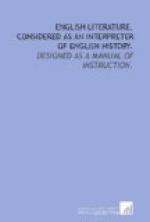ROBERT SOUTHEY.—Next to Wordsworth, and, with certain characteristic differences, of the same school, but far beneath him in poetical power, is Robert Southey, who was born at Bristol, August 12, 1774. He was the son of a linen-draper in that town. He entered Balliol College, Oxford, in 1792, but left without taking his degree. In 1794 he published a radical poem on the subject of Wat Tyler, the sentiments of which he was afterwards very willing to repudiate. With the enthusiastic instinct of a poet, he joined with Wordsworth and Coleridge in a scheme called Pantisocrasy; that is, they were to go together to the banks of the Susquehanna, in a new country of which they knew nothing except by description; and there they were to realize a dream of nature in the golden age—a Platonic republic, where everything was to be in common, and from which vice and selfishness were to be forever excluded. But these young neo-platonists had no money, and so the scheme was given up.
In 1795 he married Miss Fricker, a milliner of Bristol, and made a voyage to Lisbon, where his uncle was chaplain to the British Factory. He led an unsettled life until 1804, when he established himself at Keswick in the Lake country, where he spent his life. He was a literary man and nothing else, and perhaps one of the most industrious writers that ever held a literary pen. Much of the time, indeed, he wrote for magazines and reviews, upon whatever subject was suggested to him, to win his daily bread.
HIS WRITINGS.—After the publication of Wat Tyler he wrote an epic poem called Joan of Arc, in 1796, which was crude and severely criticized. After some other unimportant essays, he inaugurated his purpose of illustrating the various oriental mythologies, by the publication of Thalaba the Destroyer, which was received with great disfavor at the time, and which first coupled his name with that of Wordsworth as of the school of Lake poets. It is in irregular metre, which at first has the charm of variety, but which afterwards loses its effect, on account of its broken, disjointed versification. In 1805 appeared Madoc—a poem based upon the subject of early Welsh discoveries in America. It is a long poem in two parts: the one descriptive of Madoc in Wales and the other of Madoc in Aztlan. Besides many miscellaneous works in prose, we notice the issue, in 1810, of The Curse of Kehama—the second of the great mythological poems referred to.




